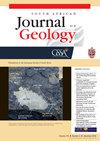刚果民主共和国南部开赛省Longatshimo山谷的钻石冲积矿床:中非钻石砂矿的沉积和经济模型
IF 1.2
4区 地球科学
Q2 GEOLOGY
引用次数: 0
摘要
刚果民主共和国南部的卡赛冲积油田是中非最大的钻石砂矿的一部分,产量超过2亿克拉,主要来自第四纪矿床。这些沉积物的一小部分,沿着和在Longatshimo河,是本研究的主题,为Kasai钻石砂矿的冲积历史提供了一瞥。这项工作记录了它们的沉积学和钻石成矿属性,以及它们的侵位过程,可以为未来的勘探模式提供信息。本文还评价了第四纪气候变化、河流景观演化和基岩条件对砂体形成的控制作用。这些过程相互作用的结果是,钻石的供应(来自白垩纪冲积源)、再循环和集中在晚第四纪最为明显和一致。因此,中非地区的冲积钻石矿化演变与南部非洲不同。从Longatshimo河谷的勘探结果来看,随着沉积年龄的减小,钻石浓度提高,但尺寸减小,因此现代河流沉积物中钻石丰度最高,但体积最小。这与南部非洲河流钻石砂矿的品位和钻石尺寸趋势相反。Longatshimo河研究提供了对Kasai冲积区的深入了解,其砂矿模型有望适用于其他中非钻石砂矿的勘探。本文章由计算机程序翻译,如有差异,请以英文原文为准。
Diamondiferous alluvial deposits of the Longatshimo Valley, Kasai Province, southern DRC: a sedimentary and economic model of a central African diamond placer
The Kasai alluvial field in southern Democratic Republic of Congo (DRC) is part of central Africa’s largest diamond placer that has produced more than 200 million carats, mainly derived from Quaternary deposits. A small part of these deposits, along and within the Longatshimo River, is the subject of this study providing a glimpse into the alluvial history of the Kasai diamond placer. This work documents their sedimentological and diamond mineralization attributes, as well as their emplacement processes, which can inform future exploration models. The key controls of this placer formation, notably Quaternary climatic variations, fluvial landscape evolution and bedrock conditions are also evaluated. A consequence of the interplay among these processes is that diamond supply (from Cretaceous alluvial sources), recycling and concentration were most pronounced and consistent, in the Late Quaternary. Alluvial diamond mineralization in this central African region thus evolved differently to those in southern Africa. Based on exploration results in the Longatshimo Valley, diamond concentration improves but diamond size diminishes with decreasing deposit age, and thus the modern river sediments contain the highest abundance but smallest diamonds. This is opposite to the grade and diamond size trend that characterises southern African fluvial diamond placers. The Longatshimo River study offers insight into the Kasai alluvial field, and its placer model is expected to be applicable to the exploration of other central African diamond placers.
求助全文
通过发布文献求助,成功后即可免费获取论文全文。
去求助
来源期刊
CiteScore
3.60
自引率
5.60%
发文量
18
审稿时长
>12 weeks
期刊介绍:
The South African Journal of Geology publishes scientific papers, notes, stratigraphic descriptions and discussions in the broadly defined fields of geoscience that are related directly or indirectly to the geology of Africa. Contributions relevant to former supercontinental entities such as Gondwana and Rodinia are also welcome as are topical studies on any geoscience-related discipline. Review papers are welcome as long as they represent original, new syntheses. Special issues are also encouraged but terms for these must be negotiated with the Editors.

 求助内容:
求助内容: 应助结果提醒方式:
应助结果提醒方式:


